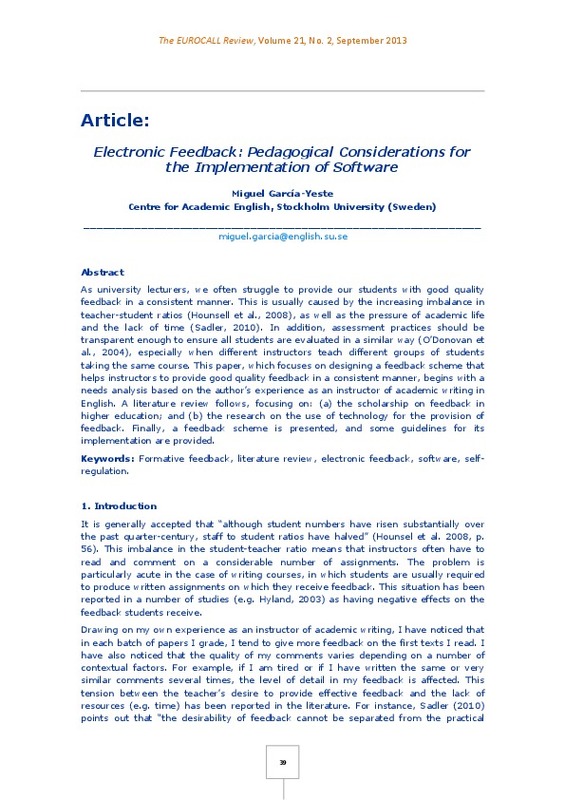Alesón, M. et al. (2006). "Assessment and online feedback: Using a written text correction programme". Proceedings of the XXIV International AESLA Conference Madrid: UNED.
Cabero, J. (2001). Tecnología educativa. Dise-o y utilización de medios de ense-anza. Barcelona: Paidós.
Carless, D. et al. (2011). "Developing Sustainable Feedback Practices". Studies in Higher Education, 36(4): 395-407. https://doi.org/10.1080/03075071003642449
[+]
Alesón, M. et al. (2006). "Assessment and online feedback: Using a written text correction programme". Proceedings of the XXIV International AESLA Conference Madrid: UNED.
Cabero, J. (2001). Tecnología educativa. Dise-o y utilización de medios de ense-anza. Barcelona: Paidós.
Carless, D. et al. (2011). "Developing Sustainable Feedback Practices". Studies in Higher Education, 36(4): 395-407. https://doi.org/10.1080/03075071003642449
Case, S. (2007). "Reconfiguring and realigning the assessment feedback processes for an undergraduate criminology degree". Assessment & Evaluation in Higher Education, 32(3): 285-299. https://doi.org/10.1080/02602930600896548
Cumming, A. (1989). "Writing Expertise and Second-Language Proficiency". Language Learning, 39: 81-135. https://doi.org/10.1111/j.1467-1770.1989.tb00592.x
DiGiovanni, E. and Nagaswami, G. (2001). "Online peer review: an alternative to face-to-face?" ELT journal 55(3): 263-272. https://doi.org/10.1093/elt/55.3.263
Hedgcock, J. & Lefkowitz, N. (1994). "Feedback on feedback: Assessing learner receptivity to teacher response in L2 composing". Journal of Second Language Writing 3(2): 141-163. https://doi.org/10.1016/1060-3743(94)90012-4
Holmes, M. (1996). "Marking student work on the computer." The Internet TESL Journal 2(9).
Hounsell, D. et al. (2008). "The quality of guidance and feedback to students". Higher Education Research & Development 27(1): 55-67. https://doi.org/10.1080/07294360701658765
Hyland, F. (2003). "Focusing on form: student engagement with teacher feedback". System 31(2): 217-230. https://doi.org/10.1016/S0346-251X(03)00021-6
Krajka, J. (2002) "Correcting student work with the computer - using dedicated software and a word processor". Teaching English with Technology. A Journal for Teachers of English 2(4) [retrieved from: http://www.iatefl.org.pl/call/j_tech10.htm].
McCune, V., & Hounsell, D. (2005). "The development of students' ways of thinking and practising in three final-year biology courses". Higher Education, 49(3): 255-289. https://doi.org/10.1007/s10734-004-6666-0
Mooij, T. (2009). "Education and ICT-based self-regulation in learning: Theory, design and implementation". Education and Information Technologies, 14(1): 3-27. https://doi.org/10.1007/s10639-008-9066-8
Nicol, D. (2006). "Increasing success in first year courses: Assessment re-design, self-regulation and learning technologies". Proceedings of the 23rd annual ascilite conference.
Nicol, D. J., & Macfarlane‐Dick, D. (2006). "Formative assessment and self‐regulated learning: A model and seven principles of good feedback practice". Studies in higher education, 31(2): 199-218. https://doi.org/10.1080/03075070600572090
O'Donovan, B. et al. (2004). "Know what I mean? Enhancing student understanding of assessment standards and criteria". Teaching in Higher Education, 9(3): 325-335. https://doi.org/10.1080/1356251042000216642
Perkins, D. (2007). "Theories of difficulty". In Entwistle, N. Student learning and university teaching. BJEP Monograph Series II, Number 4-Student Learning and University Teaching, 1(1): 1-18.
Sadler, D. R. (2010). "Beyond feedback: Developing student capability in complex appraisal". Assessment & Evaluation in Higher Education, 35(5): 535-550. https://doi.org/10.1080/02602930903541015
Thomas, J. (2004). "Using computers in correcting written work". Teaching English with Technology, 4(3): 1-8.
Tuzi, F. (2004). "The impact of e-feedback on the revisions of L2 writers in an academic writing course". Computers and Composition, 21(2): 217-235. https://doi.org/10.1016/j.compcom.2004.02.003
Ware, P., & Warschauer, M. (2006). "Automated writing evaluation: Defining the classroom research agenda". Language teaching research, 10(2): 157-180. https://doi.org/10.1191/1362168806lr190oa
[-]







![HTML file [HTML]](/themes/UPV/images/html.png)

